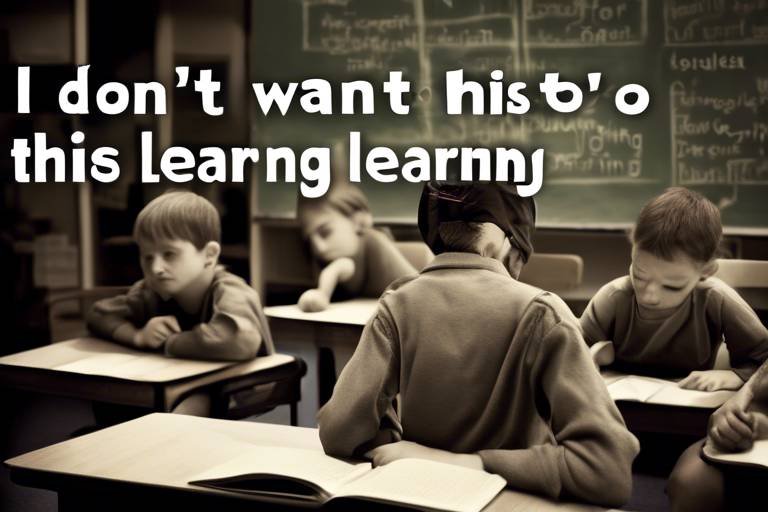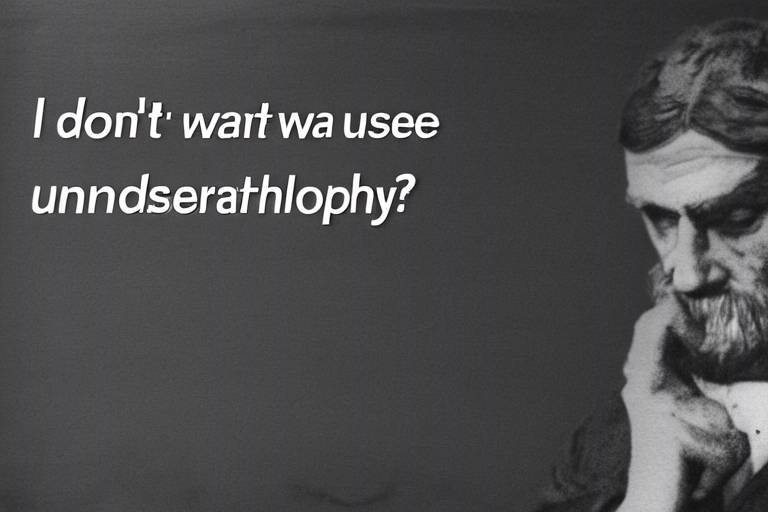The Philosophy Of Learning
This article explores the fundamental principles of learning, examining various philosophical perspectives, theories, and practical implications that shape our understanding of how we acquire knowledge and skills throughout life. Learning is not just a process; it’s a journey filled with twists and turns, much like navigating a vast ocean where each wave represents a new insight or skill. The philosophy of learning invites us to dive deeper into the essence of knowledge, the methods we use to acquire it, and the implications it has on our lives.
Understanding the essence of knowledge is crucial in the philosophy of learning. Knowledge is often viewed through the lens of epistemology, which is the study of how we know what we know. It raises questions such as: What constitutes knowledge? How do we differentiate between justified belief and mere opinion? These questions are essential because they form the foundation of our learning experiences. Knowledge isn’t static; it evolves, much like a living organism adapting to its environment. By examining various theories of knowledge, we can better appreciate the complexity of our learning processes.
When we talk about learning, we can’t ignore the major theories that have shaped our understanding of how individuals learn and develop over time. Here, we’ll explore three predominant theories: behaviorism, cognitivism, and constructivism. Each of these theories offers unique insights and approaches to learning, much like different lenses through which we can view the same landscape.
Behaviorism focuses on observable behaviors and the role of reinforcement in learning. Key figures like B.F. Skinner have emphasized how external stimuli can shape our actions. In educational settings, behaviorist approaches can be incredibly effective in creating structured environments where students can thrive. Imagine a classroom where every correct answer is met with applause, reinforcing positive behavior and encouraging engagement. This method not only motivates students but also creates a sense of achievement.
Classical conditioning, pioneered by Ivan Pavlov, illustrates how associations between stimuli can influence learning. For instance, if a student hears a bell every time they receive a reward, they may begin to associate the sound with positive outcomes. This concept has profound implications in educational contexts, as it highlights how our environment can shape our responses. By understanding these associations, educators can craft experiences that enhance learning and retention.
Operant conditioning emphasizes the impact of consequences on behavior. This theory posits that behaviors followed by rewards are likely to be repeated, while those followed by punishment are less likely to occur. In the classroom, this translates to using a system of rewards and consequences to guide student behavior. Imagine a scenario where students earn points for participation, which they can later exchange for privileges. This not only motivates students but also fosters a sense of responsibility for their learning.
On the other hand, cognitivism shifts focus to internal mental processes. This perspective is all about understanding how we think, process, and store information. Theories by Jean Piaget and Lev Vygotsky inform our understanding of cognitive development, suggesting that learning is an active process where learners construct their own understanding. Think of it like building a house; each new piece of knowledge is a brick that contributes to the overall structure of understanding. The more bricks you have, the sturdier your house becomes.
Motivation plays a pivotal role in the learning process. It can be classified into two main types: intrinsic and extrinsic. Intrinsic motivation comes from within, driven by personal satisfaction and interest, while extrinsic motivation is influenced by external factors, such as grades or rewards. Understanding these motivations is crucial for educators, as they can tailor their approaches to foster engagement and achievement. After all, a motivated learner is like a ship with its sails fully open, ready to navigate the vast seas of knowledge.
Culture significantly shapes learning experiences and perspectives. Different cultural contexts influence educational practices, values, and beliefs about knowledge and learning. For instance, in some cultures, collaborative learning is emphasized, while in others, individual achievement is prioritized. This cultural backdrop can affect how students engage with material and interact with one another. Recognizing and respecting these differences is essential for creating an inclusive learning environment that caters to all students.
Lifelong learning emphasizes the importance of continuous education throughout life. It’s not just about formal education; it’s about cultivating a mindset that values growth and development at every stage of life. This philosophy encourages individuals to seek knowledge and skills beyond traditional settings, fostering adaptability in an ever-changing world. Imagine viewing every experience as an opportunity to learn, whether it’s through a new job, a hobby, or even a conversation with a friend.
Ethical considerations are essential in the philosophy of learning. As educators and learners, we have moral responsibilities to foster an inclusive and equitable educational environment. This includes recognizing biases, promoting diversity, and ensuring that all students have access to quality education. Ethics in education is not just about following rules; it’s about creating a community where everyone feels valued and empowered to learn.
- What is the philosophy of learning? The philosophy of learning explores the fundamental principles and theories that shape our understanding of how knowledge and skills are acquired.
- Why is motivation important in learning? Motivation drives engagement and achievement, influencing how effectively individuals absorb and retain information.
- How does culture impact learning? Culture influences educational practices, values, and beliefs, affecting how students engage with material and interact with one another.
- What are the main types of learning theories? The main types of learning theories include behaviorism, cognitivism, and constructivism, each offering unique insights into the learning process.

The Nature of Knowledge
Understanding the essence of knowledge is crucial in the philosophy of learning. Knowledge is not merely a collection of facts; it is a complex interplay of beliefs, experiences, and context. Philosophers have long debated what constitutes true knowledge versus mere opinion. At the heart of this debate lies epistemology, the study of knowledge itself. This branch of philosophy seeks to answer fundamental questions: What is knowledge? How do we acquire it? And how can we differentiate between justified belief and mere opinion?
To grasp the nature of knowledge, we must first recognize that it is not static. It evolves as we gather experiences and insights throughout our lives. For instance, consider the distinction between propositional knowledge (knowing that something is the case) and procedural knowledge (knowing how to do something). This distinction is essential because it highlights the different ways we engage with knowledge. While propositional knowledge might involve memorizing facts, procedural knowledge often requires hands-on practice and application.
Moreover, knowledge can be categorized into different types, such as explicit knowledge, which is easily articulated and shared, and tacit knowledge, which is personal and context-specific, often gained through experience. For example, a skilled chef may have tacit knowledge about the perfect timing to add spices to a dish, knowledge that cannot be easily conveyed through written recipes.
In exploring these concepts, we also encounter the philosophical distinction between justified belief and opinion. Justified belief is grounded in evidence and reasoning, providing a solid foundation for claims about the world. On the other hand, opinion can be subjective and may lack the same level of support. This distinction is vital in educational settings, where fostering critical thinking and analytical skills is essential for students to navigate the vast ocean of information available to them.
As we delve deeper into the nature of knowledge, we can also consider the social dimension of learning. Knowledge is not just an individual pursuit; it is shaped by our interactions with others. Communities of practice, collaborative learning environments, and cultural contexts play significant roles in how knowledge is constructed and understood. For instance, in some cultures, knowledge is seen as a collective resource, while in others, it is viewed as an individual achievement.
Ultimately, the nature of knowledge is a dynamic and multifaceted concept. It encompasses various forms and types, influenced by our experiences, cultural backgrounds, and the philosophical frameworks we adopt. As we continue to explore the philosophy of learning, it becomes clear that understanding knowledge is not just an academic exercise; it is essential for personal growth and societal development.
- What is the difference between knowledge and belief? Knowledge is typically considered justified and true belief, whereas belief can exist without justification or truth.
- How does culture influence knowledge? Culture shapes our understanding of knowledge by influencing what is valued, how it is acquired, and how it is shared.
- What role does experience play in acquiring knowledge? Experience is crucial as it helps individuals develop tacit knowledge, which is often gained through practice rather than theoretical learning.

When we dive into the types of learning theories, we uncover a treasure trove of insights that help us understand how individuals acquire knowledge and skills. Each theory presents a unique lens through which we can view the learning process, shaping educational practices and influencing how we teach and learn. Broadly speaking, we can categorize these theories into three main groups: behaviorism, cognitivism, and constructivism. Each of these theories provides distinct perspectives and methodologies that have profound implications for education.
Behaviorism is like a spotlight on observable actions. It suggests that all behaviors are learned through interaction with the environment, primarily through reinforcement. Think of it like training a dog: when the dog sits on command and receives a treat, it’s more likely to sit again in the future. This theory, championed by figures like B.F. Skinner, emphasizes that learning is a direct response to external stimuli, making it crucial for shaping behaviors in educational settings. But it’s not just about rewards; it’s also about consequences. The implications of behaviorism can be seen in various teaching methods that rely on repetition and reinforcement to instill knowledge.
Next, we shift our focus to cognitivism, which is like peering into the black box of the mind. This theory argues that internal mental processes are key to understanding how we learn. Instead of merely focusing on observable behavior, cognitivism digs deeper into how we process information, solve problems, and develop understanding. Pioneers like Jean Piaget and Lev Vygotsky have significantly contributed to this field, emphasizing stages of cognitive development and the social context of learning. For instance, Piaget’s theory suggests that children move through distinct stages of cognitive growth, each characterized by different ways of thinking and understanding the world. This perspective encourages educators to consider the learner's mental processes and tailor their approaches accordingly.
Lastly, we encounter constructivism, which posits that learners actively construct their own understanding and knowledge of the world through experiences and reflection. It’s akin to building a house; the foundation is laid with prior knowledge, and each new experience adds another layer. Constructivist theorists advocate for hands-on learning and collaborative problem-solving, emphasizing that learners should engage with the material actively rather than passively receiving information. This theory is particularly relevant in today’s educational landscape, where project-based learning and inquiry-based approaches are gaining traction. In a constructivist classroom, you might find students working together on real-world problems, encouraging critical thinking and deeper understanding.
To sum it up, the landscape of learning theories is rich and diverse, each offering valuable insights into the learning process. Understanding these theories not only enriches our comprehension of how we learn but also informs our teaching practices. By integrating elements from behaviorism, cognitivism, and constructivism, educators can create a more holistic and effective learning environment that caters to the diverse needs of their students. This blend of theories allows for a more adaptive approach, ensuring that learning is not just a one-size-fits-all process but a tailored journey for each individual.
- What is behaviorism? Behaviorism is a learning theory that focuses on observable behaviors and the role of reinforcement in learning.
- How does cognitivism differ from behaviorism? Cognitivism emphasizes internal mental processes, while behaviorism focuses solely on observable behaviors.
- What is the main idea behind constructivism? Constructivism suggests that learners actively construct their own understanding through experiences and reflection.
- Can these theories be combined in education? Yes, integrating elements from all three theories can create a more effective and adaptive learning environment.

Behaviorism is a fascinating theory that emphasizes the role of observable behaviors in the learning process. Unlike other theories that delve into the complexities of the mind, behaviorism focuses on what can be seen and measured. Imagine a classroom where the teacher uses rewards like stickers or praise to encourage good behavior—this is a classic example of behaviorist principles in action. Pioneered by influential figures such as B.F. Skinner, behaviorism suggests that all behaviors are acquired through conditioning, which can be either classical or operant.
At its core, behaviorism proposes that learning is a response to external stimuli, and behaviors can be modified through reinforcement or punishment. This perspective has profound implications in educational settings, where teachers can shape student behavior through structured environments. For instance, when students receive positive feedback for completing homework, they are more likely to repeat that behavior. Conversely, if they face consequences for disruptive actions, they may adjust their behavior to avoid those outcomes.
Classical conditioning, a concept introduced by Ivan Pavlov, illustrates how learning occurs through associations. In his famous experiment with dogs, Pavlov demonstrated that a neutral stimulus, like a bell, could elicit a response when paired repeatedly with an unconditioned stimulus, such as food. This principle is not only applicable in psychology but also in educational contexts. For example, a student may begin to associate the sound of a bell with the start of a lesson, resulting in a conditioned response to focus and engage.
On the other hand, operant conditioning, also championed by Skinner, emphasizes the influence of consequences on behavior. Here, the idea is straightforward: behaviors followed by rewards tend to be repeated, while those followed by punishments are less likely to occur. This concept can be particularly useful in classrooms where teachers implement systems of rewards and consequences to manage student behavior. For instance, a teacher might use a token economy system where students earn tokens for good behavior, which they can later exchange for privileges or prizes. This not only motivates students but also creates a structured learning environment.
In summary, behaviorism provides valuable insights into how learning can be systematically influenced by external factors. By understanding the principles of classical and operant conditioning, educators can create effective learning environments that foster positive behaviors and enhance student engagement. The simplicity of behaviorism makes it an appealing approach, although it is essential to recognize that learning is a multifaceted process that also involves cognitive and emotional dimensions.
- What is behaviorism?
Behaviorism is a learning theory that focuses on observable behaviors and the ways they can be shaped through conditioning.
- Who were the key figures in behaviorism?
Key figures include B.F. Skinner, who developed operant conditioning, and Ivan Pavlov, known for his work on classical conditioning.
- How is behaviorism applied in education?
Teachers use behaviorist principles by reinforcing positive behaviors with rewards and addressing negative behaviors with consequences.
- What are the limitations of behaviorism?
While behaviorism is effective in modifying behaviors, it may overlook the cognitive and emotional aspects of learning.

Classical conditioning is a fascinating concept that was first introduced by the Russian physiologist Ivan Pavlov. This theory illustrates how a neutral stimulus can become associated with a significant stimulus to produce a learned response. Imagine this: Pavlov famously conducted experiments with dogs, where he noticed that they would salivate not only when food was presented but also when they heard the sound of a bell that was rung just before feeding. This led to the discovery that a neutral stimulus (the bell) could elicit a response (salivation) after being paired with an unconditioned stimulus (the food).
The implications of classical conditioning extend far beyond Pavlov's laboratory. In educational contexts, it can help explain how students develop responses to certain cues in their learning environments. For instance, a student might feel anxious when entering a classroom if they previously associated that space with stressful exams. This phenomenon highlights the importance of understanding how emotional responses can be conditioned through experiences, both positive and negative.
Here’s a brief breakdown of the key components of classical conditioning:
| Component | Description |
|---|---|
| Unconditioned Stimulus (US) | A stimulus that naturally and automatically triggers a response (e.g., food). |
| Unconditioned Response (UR) | The unlearned, naturally occurring response to the unconditioned stimulus (e.g., salivation). |
| Conditioned Stimulus (CS) | An originally irrelevant stimulus that, after association with an unconditioned stimulus, comes to trigger a conditioned response (e.g., the bell). |
| Conditioned Response (CR) | The learned response to a previously neutral stimulus (e.g., salivation in response to the bell). |
In practical terms, educators can utilize principles of classical conditioning to create positive learning environments. For example, by consistently pairing enjoyable activities with learning tasks, teachers can help students form positive associations with education. This approach not only enhances engagement but also fosters a love for learning that can last a lifetime.
However, it’s essential to recognize that classical conditioning can also lead to negative associations. If students experience fear or anxiety in a particular learning situation, those feelings can become conditioned responses. Therefore, educators must be mindful of the emotional context in which learning occurs, ensuring that students feel safe and supported.
In conclusion, classical conditioning is a powerful tool in understanding how we learn and respond to our environments. By recognizing the role of associations, educators can create more effective teaching strategies that harness the power of conditioning to promote positive learning experiences.
- What is classical conditioning? Classical conditioning is a learning process that occurs through associations between an environmental stimulus and a naturally occurring stimulus.
- Who discovered classical conditioning? The concept was discovered by Ivan Pavlov during his experiments with dogs.
- How can classical conditioning be applied in education? Educators can create positive associations with learning by pairing enjoyable activities with educational tasks.

Operant conditioning is a fascinating concept that dives deep into the relationship between behavior and its consequences. Developed by the renowned psychologist B.F. Skinner, this theory suggests that behaviors can be shaped and modified through reinforcement or punishment. Imagine teaching a dog to sit: when the dog obeys, it receives a treat, reinforcing that behavior. Conversely, if it misbehaves, it might face a consequence, such as losing playtime. This dynamic illustrates how operant conditioning operates in everyday life, not just in the realm of psychology.
At its core, operant conditioning relies on two primary components: reinforcement and punishment. Reinforcement can be positive or negative. Positive reinforcement involves providing a rewarding stimulus after a desired behavior, increasing the likelihood that the behavior will be repeated. For example, a student who receives praise for completing their homework is more likely to continue doing so in the future. On the other hand, negative reinforcement involves removing an unpleasant stimulus to encourage a behavior. Think of it as taking away a chore when a child cleans their room—this removal makes the child more likely to clean again.
Punishment, in contrast, aims to decrease the likelihood of a behavior being repeated. Just like reinforcement, punishment can also be positive or negative. Positive punishment introduces an unpleasant consequence following an undesired behavior, such as a reprimand for talking out of turn in class. Negative punishment, however, involves taking away a pleasant stimulus, like restricting screen time when a child fails to follow rules. Both types of punishment can effectively discourage undesirable behaviors, but they also come with their own set of challenges and ethical considerations.
To better understand operant conditioning, let’s take a look at a simple table that summarizes the key concepts:
| Type | Description | Example |
|---|---|---|
| Positive Reinforcement | Adding a pleasant stimulus to increase a behavior | Praising a student for good grades |
| Negative Reinforcement | Removing an unpleasant stimulus to increase a behavior | Taking away chores for good behavior |
| Positive Punishment | Adding an unpleasant stimulus to decrease a behavior | Giving extra homework for not following instructions |
| Negative Punishment | Removing a pleasant stimulus to decrease a behavior | Taking away video game privileges for poor grades |
In educational settings, operant conditioning has profound implications. Teachers can utilize reinforcement strategies to encourage positive behaviors, such as participation and collaboration. However, it’s crucial to strike a balance; relying too heavily on punishment can create a negative learning environment, leading to anxiety and disengagement. Instead, fostering a positive atmosphere where students feel motivated to learn and grow is essential.
Ultimately, operant conditioning highlights the power of consequences in shaping behavior. It serves as a reminder that our actions have ripple effects, influencing not only our own lives but also the lives of those around us. By understanding and applying the principles of operant conditioning, we can create more effective learning experiences that promote growth, resilience, and a love for knowledge.
- What is operant conditioning?
Operant conditioning is a learning process through which behaviors are modified by their consequences, specifically through reinforcement and punishment. - Who developed operant conditioning?
Operant conditioning was developed by psychologist B.F. Skinner. - How can operant conditioning be applied in education?
Teachers can use reinforcement to encourage positive behaviors and academic performance while being mindful of the potential negative impacts of punishment. - What are the differences between reinforcement and punishment?
Reinforcement aims to increase desired behaviors, while punishment seeks to decrease undesired behaviors.

Cognitivism is a fascinating approach to understanding how we learn, emphasizing the internal processes that occur in our minds. Unlike behaviorism, which focuses solely on observable behaviors, cognitivism dives deep into the mental activities that shape our learning experiences. Think of the mind as a complex computer system where information is processed, stored, and retrieved. Just like you wouldn't ignore the software when discussing a computer's performance, cognitivism highlights the significance of cognitive processes in education.
Key figures in cognitivism, such as Jean Piaget and Lev Vygotsky, have profoundly influenced our understanding of cognitive development. Piaget's theory of cognitive development outlines how children progress through distinct stages of learning, each characterized by different ways of thinking and understanding the world. For instance, during the concrete operational stage, children begin to think logically about concrete events, which significantly impacts their ability to learn mathematical concepts and scientific reasoning.
On the other hand, Vygotsky introduced the concept of the Zone of Proximal Development (ZPD), which emphasizes the importance of social interaction in learning. He argued that learners can achieve more with the help of a knowledgeable partner, such as a teacher or a peer, than they can alone. This idea underscores the value of collaborative learning environments where students can engage in dialogue, share perspectives, and collectively construct knowledge.
To illustrate the cognitive processes involved in learning, consider the following table that compares behaviorist and cognitivist approaches:
| Aspect | Behaviorism | Cognitivism |
|---|---|---|
| Focus | Observable behavior | Mental processes |
| Learning Mechanism | Reinforcement and punishment | Information processing |
| Key Theorists | B.F. Skinner | Jean Piaget, Lev Vygotsky |
| Role of the Learner | Passive recipient | Active participant |
In cognitivism, learning is viewed as an active process where learners construct their understanding based on their experiences. This perspective encourages educators to create engaging and interactive learning environments that stimulate critical thinking and problem-solving skills. Techniques such as scaffolding—providing temporary support to help learners achieve a task—are vital in facilitating cognitive growth. By gradually removing this support, educators can empower students to become independent thinkers, capable of tackling complex challenges.
Moreover, cognitive strategies like mnemonics, visualization, and concept mapping serve as practical tools to enhance memory retention and comprehension. For instance, when students create visual representations of their ideas, they not only organize information but also deepen their understanding of the subject matter. This holistic approach to learning fosters a richer educational experience, enabling students to connect new knowledge with existing frameworks.
In summary, cognitivism offers a comprehensive view of the learning process, emphasizing the importance of internal mental activities and the social context of learning. It invites us to appreciate the intricate workings of the mind and encourages educators to adopt strategies that nurture cognitive development. As we continue to explore the philosophy of learning, cognitivism stands out as a vital perspective that shapes our understanding of how individuals learn and grow throughout their lives.
- What is cognitivism? Cognitivism is a learning theory that focuses on the internal mental processes involved in learning, such as thinking, memory, and problem-solving.
- Who are the key theorists associated with cognitivism? Key figures include Jean Piaget, who developed theories on cognitive development, and Lev Vygotsky, known for his work on social learning and the Zone of Proximal Development.
- How does cognitivism differ from behaviorism? While behaviorism focuses on observable behaviors and external stimuli, cognitivism emphasizes the mental processes that underlie learning.
- What are some practical applications of cognitivism in education? Techniques such as scaffolding, concept mapping, and the use of cognitive strategies like mnemonics are common applications of cognitivist principles in educational settings.

Motivation is the fuel that drives our learning journey. Just like a car needs gas to reach its destination, learners require motivation to engage with new material and persist through challenges. But what exactly is motivation, and how does it influence our ability to learn? To put it simply, motivation can be categorized into two primary types: intrinsic and extrinsic.
Intrinsic motivation refers to the internal desire to learn and grow. Imagine a child who is captivated by the beauty of nature, spending hours exploring the outdoors simply for the joy of discovery. This type of motivation is powerful because it fosters a deep connection to the material. When learners are intrinsically motivated, they are more likely to take ownership of their education, leading to a richer and more meaningful learning experience.
On the other hand, extrinsic motivation involves external rewards or pressures. Consider a student who studies hard for an exam to earn a high grade or to avoid disappointing their parents. While extrinsic motivation can be effective in the short term, it often lacks the depth and sustainability of intrinsic motivation. When the external rewards disappear, so too can the motivation to learn. Therefore, striking a balance between these two types of motivation is crucial for effective learning.
Research has shown that motivation significantly influences engagement and achievement in educational environments. Motivated learners tend to exhibit higher levels of persistence, creativity, and overall performance. They are more likely to seek out challenges and embrace failure as a stepping stone to success. In contrast, unmotivated learners may struggle to stay focused, leading to a cycle of disengagement and underachievement.
So, how can educators and learners cultivate motivation in the classroom? Here are some strategies:
- Set clear goals: Defining specific and achievable goals can help learners understand what they are working towards, making the learning process feel more purposeful.
- Provide feedback: Constructive feedback encourages learners to reflect on their progress and understand areas for improvement, boosting their motivation to excel.
- Foster a positive environment: Creating a supportive and inclusive classroom atmosphere can help students feel valued and motivated to participate actively.
- Encourage autonomy: Allowing learners to make choices about their learning can enhance their intrinsic motivation, making them feel more invested in the process.
Ultimately, the role of motivation in learning cannot be overstated. It shapes not only how we engage with educational material but also how we perceive our abilities and potential. By recognizing and nurturing both intrinsic and extrinsic motivations, we can create a dynamic and enriching learning environment that empowers individuals to reach their full potential.
Q: What is the difference between intrinsic and extrinsic motivation?
A: Intrinsic motivation comes from within the learner, driven by personal satisfaction and interest in the subject. Extrinsic motivation is influenced by external factors, such as rewards or recognition.
Q: How can I increase my intrinsic motivation?
A: To boost intrinsic motivation, focus on setting personal goals, finding relevance in the material, and engaging in activities that spark your curiosity and passion.
Q: Why is motivation important in education?
A: Motivation is crucial because it affects engagement, persistence, and overall performance in learning. Motivated learners are more likely to take risks, embrace challenges, and achieve their academic goals.

Culture is like the air we breathe; it surrounds us and influences nearly every aspect of our lives, including how we learn. When we talk about the impact of culture on learning, we’re diving into a complex interplay between our backgrounds, beliefs, and the educational systems we engage with. Imagine trying to piece together a puzzle without knowing the picture on the box; that’s what learning can feel like without the context provided by culture. Different cultures have unique values, practices, and expectations regarding education, which profoundly shape how individuals acquire knowledge and skills.
For instance, in collectivist cultures, the emphasis might be on group harmony and collaboration, which can lead to a preference for group learning activities. In contrast, individualistic cultures often promote self-directed learning and personal achievement. This divergence can affect not only how students engage with material but also how they interact with peers and educators.
To illustrate this further, let’s consider a few key cultural dimensions that impact learning:
| Cultural Dimension | Impact on Learning |
|---|---|
| Collectivism vs. Individualism | Collectivist cultures may prioritize group projects and collaborative learning, while individualistic cultures encourage independent study and personal responsibility. |
| Power Distance | In cultures with high power distance, students may be less likely to question authority, affecting classroom dynamics and participation. |
| Uncertainty Avoidance | Students from cultures with high uncertainty avoidance may prefer structured learning environments with clear guidelines, while those from low uncertainty avoidance cultures may thrive in more open-ended situations. |
These dimensions highlight how cultural backgrounds can shape not just what is learned, but how it is learned. For example, students from high power distance cultures might hesitate to voice their opinions in class discussions, impacting their engagement and comprehension. Conversely, students from low power distance cultures might feel more empowered to contribute actively, leading to a more dynamic learning experience.
Furthermore, cultural attitudes towards failure also play a significant role in the learning process. In some cultures, failure is seen as a stepping stone to success, promoting resilience and a growth mindset. In others, it may carry a stigma that discourages risk-taking and experimentation. This can create a significant difference in how students approach challenges and setbacks in their educational journeys.
It’s also worth noting that educators must be culturally responsive to effectively engage students from diverse backgrounds. This means recognizing and respecting the different cultural frames that students bring into the classroom. By incorporating culturally relevant materials and teaching strategies, educators can create a more inclusive environment that acknowledges and values diversity.
In conclusion, the impact of culture on learning is profound and multifaceted. It shapes not only the content of what is taught but also the methods and attitudes towards learning itself. As we navigate an increasingly globalized world, understanding these cultural influences becomes essential for fostering effective and equitable educational experiences.
- How does culture influence learning styles?
Culture can dictate whether students prefer collaborative or independent learning, affecting their engagement and success in educational settings. - What role do teachers play in addressing cultural differences?
Teachers can create inclusive classrooms by recognizing cultural backgrounds and adapting their teaching methods accordingly. - Can cultural differences impact student motivation?
Yes, cultural attitudes towards success, failure, and education can significantly influence student motivation and engagement levels.

Lifelong learning is not just a buzzword; it’s a philosophy that champions the idea of continuous education throughout one’s life. Imagine your brain as a sponge, always ready to soak up new information, skills, and experiences. This concept transcends formal education, inviting us to embrace learning in every aspect of our lives. From picking up a new hobby to mastering a professional skill, lifelong learning is about cultivating a mindset that values curiosity and growth.
The roots of lifelong learning can be traced back to various philosophical underpinnings. Thinkers like John Dewey emphasized experiential learning, arguing that education should be a dynamic process, adapting to the needs and interests of individuals. In today’s fast-paced world, where technology and knowledge are evolving at lightning speed, the ability to learn continuously is not just an asset; it’s a necessity. The more we learn, the more we can adapt, innovate, and thrive in our personal and professional lives.
So, what does lifelong learning look like in practice? It can take many forms, such as:
- Formal Education: Enrolling in courses, workshops, or degree programs.
- Informal Learning: Gaining knowledge through life experiences, reading, or online resources.
- Professional Development: Attending seminars or training sessions to enhance skills relevant to one’s career.
Moreover, the benefits of lifelong learning are profound. Not only does it keep our minds sharp, but it also enhances our adaptability in the face of change. In an age where job roles are constantly shifting, being a lifelong learner equips us with the tools to navigate these transitions with ease. It fosters resilience, making us more prepared for challenges that life throws our way.
Additionally, lifelong learning contributes to personal fulfillment. Engaging in new learning experiences can reignite our passions, broaden our horizons, and even lead to new friendships and networks. It’s like adding vibrant colors to the canvas of our lives, transforming the mundane into something extraordinary.
In summary, the philosophy of lifelong learning encourages us to embrace curiosity and adaptability. It’s a commitment to growth that can profoundly impact our lives, both personally and professionally. By cultivating a mindset that values learning, we not only enhance our own lives but also contribute positively to our communities and society as a whole.
- What is lifelong learning? Lifelong learning refers to the ongoing, voluntary, and self-motivated pursuit of knowledge for personal or professional development.
- Why is lifelong learning important? It helps individuals adapt to changes, enhances career prospects, and fosters personal growth and fulfillment.
- How can I engage in lifelong learning? You can participate in formal education, read books, take online courses, or engage in community activities that promote learning.

When we think about education, we often focus on the content being taught, the methods of delivery, and the outcomes for students. However, one crucial aspect that often gets overshadowed is the ethical dimension of education. Ethics in education encompasses the moral principles that guide the behavior of educators, students, and institutions. It is about ensuring that the learning environment is not only informative but also just, inclusive, and equitable.
At its core, ethics in education involves a commitment to fostering an environment where all students feel valued and respected. This means that educators have a moral responsibility to promote fairness and to recognize the diverse backgrounds and needs of their students. For instance, when designing curricula, teachers must consider how their materials reflect the values and cultures of all students, rather than just a dominant narrative. This is not just about avoiding bias; it’s about actively creating a space where every voice matters.
Moreover, ethical considerations extend to the relationships formed within educational settings. Teachers must navigate the delicate balance between authority and trust. Establishing a rapport with students while maintaining professional boundaries is essential. This relationship is pivotal in creating a safe space for learning, where students can express their thoughts and feelings without fear of judgment or reprisal.
In addition, educators are often faced with ethical dilemmas that require them to make tough decisions. For example, how should a teacher respond when a student is being bullied? Should they intervene directly, or should they involve parents and administrators? These situations demand a careful consideration of the impact of their actions on all parties involved. It’s essential for teachers to have a solid understanding of ethical frameworks to guide their decision-making processes.
Furthermore, ethical education is not solely the responsibility of teachers. Students also have a role to play in cultivating an ethical learning environment. They must learn to engage with their peers respectfully and to challenge injustices when they see them. This can be fostered through discussions about empathy, respect, and responsibility within the classroom. By encouraging students to reflect on their actions and the consequences they may have on others, educators are helping to shape future citizens who are not only knowledgeable but also morally responsible.
To summarize, ethics in education is a multifaceted issue that touches on various aspects of the learning experience. It involves:
- Creating an inclusive environment: Ensuring that all students feel represented and valued.
- Building trust: Establishing strong relationships between educators and students.
- Navigating ethical dilemmas: Making informed decisions that consider the well-being of all students.
- Encouraging student responsibility: Teaching students to be aware of their actions and their impact on others.
As we continue to evolve in our understanding of education, integrating ethical considerations will be crucial in shaping not just knowledgeable individuals but also compassionate and responsible members of society.
Q1: What are the main ethical issues in education?
A1: The main ethical issues in education include inclusivity, fairness, respect for diversity, and the handling of sensitive situations such as bullying or discrimination.
Q2: How can educators promote ethical behavior in students?
A2: Educators can promote ethical behavior by modeling respectful interactions, facilitating discussions on moral dilemmas, and encouraging students to reflect on the consequences of their actions.
Q3: Why is ethics important in education?
A3: Ethics is important in education because it ensures that the learning environment is fair, inclusive, and respectful, which ultimately contributes to the holistic development of students.
Frequently Asked Questions
- What is the philosophy of learning?
The philosophy of learning explores the fundamental principles that guide how we acquire knowledge and skills. It examines various theories and perspectives that shape our understanding of learning throughout life, tackling questions about the nature of knowledge and the processes involved in learning.
- What are the main types of learning theories?
There are several key learning theories, including behaviorism, cognitivism, and constructivism. Each of these theories offers unique insights into how individuals learn. For instance, behaviorism focuses on observable behaviors and the role of reinforcement, while cognitivism emphasizes internal mental processes and cognitive development.
- How does motivation affect learning?
Motivation plays a crucial role in the learning process. It can be intrinsic, coming from within the learner, or extrinsic, driven by external rewards. Understanding these types of motivation helps educators create engaging learning environments that encourage students to achieve their full potential.
- In what ways does culture impact learning?
Culture significantly influences learning experiences and perspectives. It shapes educational practices, values, and beliefs about knowledge. For instance, cultural backgrounds can affect communication styles, learning preferences, and the importance placed on collaboration versus individual achievement.
- What is lifelong learning, and why is it important?
Lifelong learning refers to the ongoing, voluntary, and self-motivated pursuit of knowledge for personal or professional development. It is essential because it fosters adaptability and growth in an ever-changing world, enabling individuals to continuously enhance their skills and remain relevant in their fields.
- What ethical considerations are important in education?
Ethics in education encompass the moral responsibilities of both educators and learners. It involves creating an inclusive and equitable learning environment that respects diversity and promotes fairness. Ethical considerations also include honesty in assessments and the importance of fostering a supportive atmosphere for all students.



















